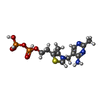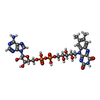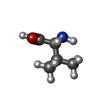+Search query
-Structure paper
| Title | Structures of fungal and plant acetohydroxyacid synthases. |
|---|---|
| Journal, issue, pages | Nature, Vol. 586, Issue 7828, Page 317-321, Year 2020 |
| Publish date | Jul 8, 2020 |
 Authors Authors | Thierry Lonhienne / Yu Shang Low / Mario D Garcia / Tristan Croll / Yan Gao / Quan Wang / Lou Brillault / Craig M Williams / James A Fraser / Ross P McGeary / Nicholas P West / Michael J Landsberg / Zihe Rao / Gerhard Schenk / Luke W Guddat /    |
| PubMed Abstract | Acetohydroxyacid synthase (AHAS), also known as acetolactate synthase, is a flavin adenine dinucleotide-, thiamine diphosphate- and magnesium-dependent enzyme that catalyses the first step in the ...Acetohydroxyacid synthase (AHAS), also known as acetolactate synthase, is a flavin adenine dinucleotide-, thiamine diphosphate- and magnesium-dependent enzyme that catalyses the first step in the biosynthesis of branched-chain amino acids. It is the target for more than 50 commercial herbicides. AHAS requires both catalytic and regulatory subunits for maximal activity and functionality. Here we describe structures of the hexadecameric AHAS complexes of Saccharomyces cerevisiae and dodecameric AHAS complexes of Arabidopsis thaliana. We found that the regulatory subunits of these AHAS complexes form a core to which the catalytic subunit dimers are attached, adopting the shape of a Maltese cross. The structures show how the catalytic and regulatory subunits communicate with each other to provide a pathway for activation and for feedback inhibition by branched-chain amino acids. We also show that the AHAS complex of Mycobacterium tuberculosis adopts a similar structure, thus demonstrating that the overall AHAS architecture is conserved across kingdoms. |
 External links External links |  Nature / Nature /  PubMed:32640464 PubMed:32640464 |
| Methods | EM (single particle) / X-ray diffraction |
| Resolution | 3.194 - 3.8 Å |
| Structure data | EMDB-20700, PDB-6u9h: EMDB-21487, PDB-6vz8:  PDB-6u9d:  PDB-6wo1: |
| Chemicals |  ChemComp-TPP:  ChemComp-MG:  ChemComp-FAD:  ChemComp-60G:  ChemComp-ATP:  ChemComp-HOH:  ChemComp-VAL:  ChemComp-8GF:  ChemComp-DPO: |
| Source |
|
 Keywords Keywords |  TRANSFERASE / AHAS / TRANSFERASE / AHAS /  pyruvate / FAD / pyruvate / FAD /  dioxygen / dioxygen /  PLANT PROTEIN / PLANT PROTEIN /  Complex Complex |
 Movie
Movie Controller
Controller Structure viewers
Structure viewers About Yorodumi Papers
About Yorodumi Papers










